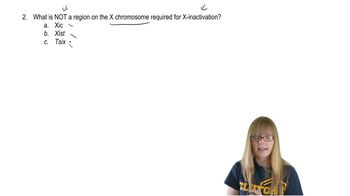Table of contents
- 1. Introduction to Genetics51m
- 2. Mendel's Laws of Inheritance3h 37m
- 3. Extensions to Mendelian Inheritance2h 41m
- 4. Genetic Mapping and Linkage2h 28m
- 5. Genetics of Bacteria and Viruses1h 21m
- 6. Chromosomal Variation1h 48m
- 7. DNA and Chromosome Structure56m
- 8. DNA Replication1h 10m
- 9. Mitosis and Meiosis1h 34m
- 10. Transcription1h 0m
- 11. Translation58m
- 12. Gene Regulation in Prokaryotes1h 19m
- 13. Gene Regulation in Eukaryotes44m
- 14. Genetic Control of Development44m
- 15. Genomes and Genomics1h 50m
- 16. Transposable Elements47m
- 17. Mutation, Repair, and Recombination1h 6m
- 18. Molecular Genetic Tools19m
- 19. Cancer Genetics29m
- 20. Quantitative Genetics1h 26m
- 21. Population Genetics50m
- 22. Evolutionary Genetics29m
10. Transcription
Overview of Transcription
Problem 39a
Textbook Question
Answer the following questions about the accompanying diagram.

What structure is closest to E? Be specific.
 Verified step by step guidance
Verified step by step guidance1
Identify the labeled structures in the diagram: A is DNA, B is RNA polymerase, C is mRNA, D is ribosome, E is tRNA, F is polypeptide chain, G is amino acids.
Locate the position of label E in the diagram, which is attached to the mRNA strand and interacting with the ribosome.
Understand that tRNA (E) is responsible for bringing amino acids to the ribosome during translation.
Determine the structure closest to E, which is the ribosome (D) as it is directly interacting with the tRNA during protein synthesis.
Conclude that the structure closest to E is the ribosome, which facilitates the translation process by reading the mRNA and forming the polypeptide chain.
Recommended similar problem, with video answer:
 Verified Solution
Verified SolutionThis video solution was recommended by our tutors as helpful for the problem above
Video duration:
2mPlay a video:
Was this helpful?
Key Concepts
Here are the essential concepts you must grasp in order to answer the question correctly.
Transcription
Transcription is the process by which the genetic information encoded in DNA is copied into messenger RNA (mRNA). This process involves the enzyme RNA polymerase, which binds to the DNA at a specific region and synthesizes a complementary RNA strand. Understanding transcription is crucial for identifying the roles of various structures in the diagram, particularly in relation to structure E.
Recommended video:
Guided course

Eukaryotic Transcription
RNA Polymerase
RNA polymerase is the enzyme responsible for synthesizing RNA from a DNA template during transcription. It unwinds the DNA double helix and adds RNA nucleotides to form a single-stranded RNA molecule. In the context of the diagram, structure E is likely associated with RNA polymerase, making it essential to recognize its function and position relative to other structures.
Recommended video:
Promoter Region
The promoter region is a specific sequence of DNA located upstream of a gene that signals the start of transcription. It is where RNA polymerase binds to initiate the transcription process. In the diagram, structure E may be located near the promoter, which is critical for understanding the spatial relationships between the structures and their roles in gene expression.
Recommended video:
Guided course

Regions of X Chromosomes

 6:32m
6:32mWatch next
Master Overview of Transcription with a bite sized video explanation from Kylia Goodner
Start learningRelated Videos
Related Practice



